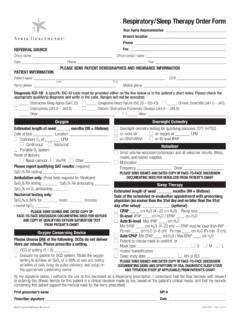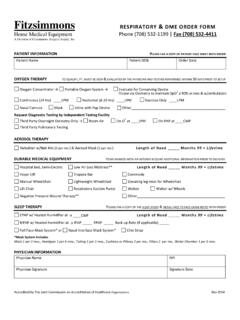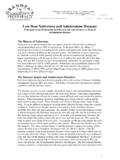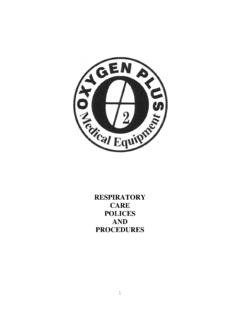Transcription of BiPAP CPAP Protocal - Desmond Paul Allen
1 1 BiPAP / cpap Protocol Title: BiPAP / cpap Protocol EFFECTIVE DATE:_____ APPROVED:_____ POLICY The MD, or the RCP (pursuant to the MD s medical order for respiratory therapy to follow the BiPAP / cpap protocol), shall determine BiPAP / cpap settings based upon each patient s diagnosis and immediate clinical demand. PURPOSE The objective is to facilitate the emergent application, management, and timely discontinuation of BiPAP / cpap therapies via facemask. SCOPE The following guidelines transcend the solely physician driven approach to BiBAP/ cpap therapies, thereby allowing the RCP to make timely, necessary adjustments to manage the patient s immediate clinical demand as his/her condition changes. DEFINITION OF TERMS cpap (Continuous Positive Airway Pressure) delivers a single, constant pressure during both inhalation and exhalation.
2 BiPAP (Bi-level Positive Airway Pressure) or NPPV (Noninvasive Positive Pressure Ventilation) delivers two pressures. The lesser pressure, referred to as ePAP (Expiratory Positive Airway Pressure), is delivered upon exhalation. It is very similar to, and can achieve the same objective, as cpap . The second and greater pressure, referred to as iPAP (Inspiratory Positive Airway Pressure) is delivered during inhalation. OBJECTIVE OF cpap /EPAP IN ACUTE RESPIRATORY FAILURE cpap /ePAP is generally employed to achieve one of two objectives: (1) to splint the upper airway as a treatment for sleep apnea; or (2) to augment oxygenation in the presence of refractory hypoxemia ( PaO2 < 60mm HG, or SaO2 < 90% with FiO2 > 60%). Our concern in this protocol is with the second objective, the treatment of refractory hypoxemia. This form of respiratory failure is generally cased by a ventilation/perfusion mismatch; which is often observed in such conditions as CHF, atelectasis, pulmonary embolism and pneumonia.
3 cpap /ePAP treats refractory hypoxemia by increasing and maintaining alveolar pressures, which in turn promotes alveolar recruitment and oxygen diffusion. 2 OBJECTIVE OF BiPAP IN ACUTE RESPIRATORY FAILURE BiPAP may be employed to treat acute or pending respiratory failure. Because iPAP the greater pressure of the two augments ventilation, BiPAP can be an effective treatment for acute hypercapnia. COPD, multiple rib fractures with a flail segment or even extreme pain secondary to a post-operative incision are common causes of acute hypercapnia. Because ePAP the lesser pressure o the two is similar to cpap pressure, BiPAP can also be used to treat refractory hypoxemia, with the additional bonus of assisting ventilation if necessary. When treating acute hypercapnic respiratory failure, the distance between the iPAP and ePAP pressures is of primary importance.
4 Ventilatory assistance increases as the distance between these two settings widens. For example, an iPAP/ ePAP of 16/6 provides greater ventilatory assistance than does 12/6, whereas both settings provide the same degree of oxygenation augmentation, because both 16/6 and 12/6 have ePAP settings of 6 cm H20. CONTRAINDICATIONS TO cpap / BiPAP therapy The following conditions are contraindications for cpap / BiPAP therapy : 1. Patients with severe respiratory failure without a spontaneous respiratory drive. 2. Decreased level of consciousness that prevents the patient s ability to protect his/her own airway. 3. Inability to maintain a patent airway or adequately clear secretions. 4. Non-compliant patient. The following conditions may be contraindicated to cpap / BiPAP therapy , so that the risk versus benefit of ventilatory assistance should be considered: 1.
5 Risk for aspiration of gastric content. In such cases a NG tube can be helpful. 2. Bullous lung disease (emphysema). 3. Pre-existing pneumothroax or pneumomediastinum, which may be complicated due to the increased pressure. 4. Hypotension. 5. Acute sinusitis or otitis media. 6. Epistaxis. 7. Recent facial, oral or skull surgery or trauma. 8. History of allergy or sensitivity to mask materials. 3 POTENTIAL COMPLICATIONS 1. Skin breakdown and discomfort from mask. While the initial skin integrity is an issue, breakdown is a virtually certainty for everyone after several days of continuous therapy . 2. Gastric distention. 3. Increased intracranial pressure. 4. Pulmonary barotraumas. 5. Cardiovascular compromise. SELECTION OF therapy To determine the therapeutic objective, answer the following questions. What is being treated: Acute hypercapnia?
6 Refractory hypoxemia? Or both? 1. If refractory hypoxemia is the sole issue cpap is the desired treatment. Here, ventilatory assistance is not an issue. As evidence by ABGs, it is not uncommon for CHF patients suffering acute refractory hypoxemia to be hyperventilating. In such cases additional ventilatory support will further decrease an already low PC02. 2. If acute hypercapnia is the sole issue, BiPAP with a low ePAP setting is the desired treatment; for here ventilation is the issue, while oxygenation augmentation is not. 3. If both refractory hypoxemia and acute hypercapnia are at issue, BiPAP with a higher ePAP pressure is the desired treatment; for here both ventilatory assistance and oxygenation augmentation are of concern. SETTINGS All settings are considered dynamic, in that they may need adjustment to meet patient demand as his/her condition changes.
7 The following guidelines provide a standardized basis from which to initiate settings and make said changes. cpap /ePAP settings for Refractory Hypoxemia 1. Fio2 100%. 2. Set cpap /ePAP pressure to 8 cm H2O. Increase/Decrease in increments of 2 cm H2O, as tolerated, to maintain desired SaO2 ( > 90%). If a cpap /ePAP setting > 14 cm H2O fails to maintain desired SaO2, notify physician to consider other options: increased cpap /ePAP pressure, additional pharmaceutical interventions, dialysis, or possible intubation. Management and Weaning from cpap /ePAP with refractory hypoxemia 1. Decrease ePAP in increments of 2 cm H2O while maintaining desired SaO2. Once desired SaO2 is maintained at < 8 cm H2O, begin to periodically decrease FiO2 by 10% increments while maintaining desired SaO2. 42. Once FiO2 50% is achieved and desired SaO2 is maintained, begin to periodically decrease ePAP in increments of 2 cm H2O as tolerated.
8 3. Once desired SaO2 is maintained with FiO2 50% and cpap /ePAP 4 cm H2O, place patient on 50% venti-mask. If unable to maintain desired SaO2, resume cpap /ePAP at the lowest setting necessary to maintain SaO2. Attempt 50% venti-mask trials as tolerated. BiPAP settings for Acute Hypercapnia 1. Set FiO2 from 21% to 50% to maintain desire SaO2 (e,g. 88% for known PCo2 retainers; 90% if refractory hypoxemia also an issue; 92% for all others). If refractory hypoxemia is also an issue, use 100% as stated above under cpap /ePAP settings for Refractory Hypoxemia. 2. Set ePAP from 4 to 6 cm H20. If refractory hypoxemia is an issue, begin at 8 cm H20 as stated above under cpap /ePAP settings for Refractory Hypoxemia. 3. Set iPAP 6 to 12 cm H2O above selected ePAP setting ( 10/4, 14/6, 16/4, etc.). At times the initial iPAP setting might exceed 12 cm H2O above ePAP due to patient demand.
9 Ultimately, theses setting are best determined by the degree of ventilatory assistance deemed necessary as indicated by patient comfort and clinical indications: minute volume, respiratory rate, observed work of breathing, and ABGs if deemed necessary. Management and Weaning from BiPAP 1. Incrementally increase/decrease iPAP by 2 cm H2O while continuing to meet the patient s ventilatory needs as evidenced by patient comfort and clinical indications. 2. Incrementally increase/decrease FiO2 to maintain desired SaO2. 3. Once iPAP 6 cm H2O above ePAP is achieved with patient comfort and clinical signs remain stable, attempt to remove BiPAP for short periods as tolerated. Place patient on an appropriate and adequate Fi02 source to maintain desire SaO2 during these trials. Increase the duration and frequency of these trials as tolerated. 4. If refractory hypoxemia is also an issue, follow the ePAP weaning procedure described above (see Management and Weaning from cpap /ePAP with refractory hypoxemia) before attempting BiPAP removal trials.
10 5. Patient should be immediately returned to BiPAP upon any clinical signs of distress; such as SaO2 below desired goal, markedly increased HR (> 20%), marked increased work of breathing, or patient-stated SOB/discomfort, etc. Flow and Alarm Settings Begin with a default Rise Time of sec and a default Timed Inspiration of sec. Adjust as needed to meet patient demand. Back up Rate of 10 to 12 BPM. All alarms should coincide with patient s parameters. For example, Hi P = 5 cm H20 above iPAP, Lo P = 5 cm H20 below iPAP, Lo P Delay = 20 sec. Set all the other alarms as appropriate for each patient: Apnea, Lo Min Vent, Hi Rate, Lo Rate, etc. 5 PATIENTS ON HOME therapy FOR DIAGNOSED sleep APNEA For the following reasons, chronic sleep apnea patients being treated for diagnoses other than acute hypercapnic or refractory hypoxemic respiratory failure are encouraged to bring their personal cpap equipment from home.









